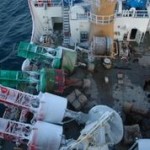
The USCGC Mackinaw (WLBB-30) was commissioned on June 10, 2006 to maintain large scale ice breaking abilities in the Great Lakes region (5). WLBB-30 replaced its predecessor, USCGC Mackinaw (WAGB-83) who served the Great Lakes for over 60 years (7). It became the largest Coast Guard Cutter in the Great Lakes. At a length of 240 feet, the Mackinaw can cut through 42 inches of solid ice and over 12 feet of brash ice. The Cutter serves many purposes including buoy tending, domestic ice breaking, law enforcement, environmental response, aids to navigation, and search and rescue (7).
Ice breaking in the Great Lakes began in 1872 when Alpena Harbor filled with ice and Commodore Louis Boynton dispatched two ferries to break it up. With the development of ferries used to carry rail and automobiles across the Straits of Mackinaw, ship operators began to rely on the ferries to assist them in breaking out of the ice. By 1936, the U.S. Coast Guard began maintaining shipping lanes and keeping them free of ice (2). The construction of true American ice breakers began in 1941 when President Franklin Roosevelt order the construction of the Wind class ships. When the U.S. entered World War II, the Navy moved 2 Coast Guard cutters out of the Great Lakes. This created an extreme need for an ice breaker in the Great Lakes that could operate year round. Eventually, Congress approved funding for an ice breaker to operate year round on the Great Lakes alone (2).
The First Mackinaw
Two naval architects from New York city completed the designs for the first Mackinaw and the contract was awarded to the Toledo Ship Building Company. The Toledo Ship Building Company eventually lost the contract due to bankruptcy and the American Shipbuilding and Dry Dock Company took over the contract. The USCGC Mackinaw (WAGB-83) was launched in March 1944 and was commissioned on December 20 of that year (8). The Mackinaw was originally destined to be docked in Milwaukee, Wisconsin but ended up in Cheboygan, Michigan. This location was chosen because most of the shipping traffic was located in the Straits of Mackinac and Cheboygan would provide easier access to this region. Three days after the Mackinaw docked in Cheboygan it was dispatched for its first mission, summoned to Sault Ste. Marie, Bay City, and Chicago to perform ice breaking and escort duties (8).
The first Mackinaw was powered by six, ten cylinder engines that produced 2000 horsepower. The ship was able to travel at a maximum speed of 21.6 miles per hour. The engine was connected to 6 electric generators that could be used to power 3 main propulsion motors of 5,000 horsepower each (6). The Mackinaw was the largest and strongest vessel that the Great Lakes had seen and was dubbed the “Mighty Mac”. This ship was capable of breaking 40 feet of wind throw ice and 42 inches of blue ice. With the increased ice breaking capabilities that the Mackinaw brought to the Great Lakes, the shipping channels and commerce remained open year round.
The first USCGC Mackinaw (WAGB-83) served the Great Lakes with excellence for over 60 years. The vessel was the largest and most powerful ice breaker anywhere in the world at that time. It represented the start of the art icebreaking technology available. In the early 2000s she begun reaching the end of her service life. The ship was no longer state of the art technology and did not command the presence in the Great Lakes that it formally held. The titan was finally decommissioned in 2006 after it began to become too expensive and difficult to maintain. The ship was designated to become The Icebreaker Mackinaw Maritime Museum located in Mackinaw City, Michigan. With the passing of this titan on the Great Lakes, a new titan had to be constructed.
The Building of the New Mackinaw
When the Coast Guard began noticing that the Mackinaw (WAGB 83) was reaching the end of its service, they began to inquire about building a new ship. Congress began to push the Coast Guard to reacquire ice breaking capabilities in the Great Lakes. Two companies, Halter Marine and Marinette Marine bid for the contract to build the new ship. The contract was eventually awarded to Marinette Marine in 2001. The building of the ship commenced immediately (1). In this period of time the Coast Guard was undergoing multiple budget cuts that removed some of the smaller capability tugboats and buoy tenders from service. This influenced the design of the ship so it could perform multiple duties other than icebreaking (8). The creation of new technologies caused the new version of the Mackinaw to be designed to be run by a much smaller crew than the original vessel. Capt. Jonathan Nickerson was part of the design process that identified what was needed to keep the Great Lakes open during long winters. The New Mackinaw was planned to be another one-of-a-kind icebreaker in the Coast Guard’s fleet. The ship was planned to be 240 feet long with a beam of 58 feet (1).
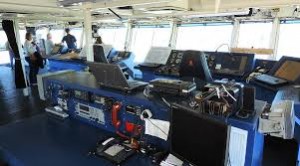
The new Mackinaw (WLBB-30) was defined as a cutter vessel. A cutter is defined as a ship that is at least 65 feet long and has the capacity to accommodate a permanently assigned crew. The acronym WLBB is given to the new ship for many reasons. The W has been applied to all Coast Guard ships since WWII. The L stands for working boat or load-bearing and the B is for big. All tenders over 225 feet are designated as WLB. WLB’s are the Coast Guard’s designation for sea-going buoy tenders. The last B is for [ice] breaker (5). The predecessor to WLBB-30 could only serve as an ice breaker while the new ship was designed also perform the various duties of buoy tending. The new breaker’s design uses two fully azimuthing protected propellers. This means that the propellers can rotate a full 360 degrees for added maneuverability (8). The ship is powered by 3 Caterpillar Turbocharged V-12 engines that drive 2 ABB electric propulsion drives that deliver a combined 9,200 horsepower. They are Caterpillar 3612 engines, turning Kato Generators. Mackinaw has 3 MDG’s. Each producing about 3.5 Megawatts of electric power. Mackinaw has an integrated electric plant. This means that the main generators provide electric power for both propulsion (Azipods) and ship’s hotel services (everything else). Most ships have separate generators or engines for each.
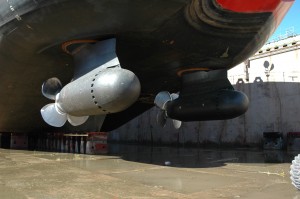
The Mackinaw’s azipods (propellers) rotate 360 degrees in either direction, infinitely, so you can spin them round and round. They allow exceptional maneuverability, both in open water and ice breaking. The old Mackinaw had straight line propeller shafts and rudders. So it could not turn very well, especially in the ice. These Azipods actually help the Mackinaw to break more ice going astern (backwards), than going forwards. Each Azipod has approximately 4500 horsepower, (3.4 Megawatts). The propellers are made of a super high strength stainless steel developed just for icebreakers by the Coast Guard. When going backwards in the ice, the props are turned around and pull the ship, and actually mill their way through the ice, kind of like a blender. The Mackinaw also has a 500 horsepower tunnel thruster located at the bow (8). The Mackinaw ’s bridge utilizes the most modern computer systems in the Coast Guard fleet. The bridge is fully integrated combining the control-and-navigation system, voyage-planning system, dynamic-positioning system, and an electronic chart-display-and information system and radar. Main Engineering Control Center (from John Comar)All of these complicated systems can be operated by one crew member in unrestricted waters. The ship also contains a Main Propulsion Control and Monitoring System console. These consoles control all of the engineering systems on board, including the engines and propulsors.
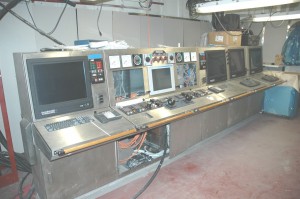
Due to the new technological advances, the ship is run by a very small crew of 50 members. Approximately nine of these members are officers (8). The Great Lakes operate on a 42-week shipping season. On the average year, ice breaking is required for 12 weeks. The ship was designed to cut a 300 foot wide channel at a depth of 21 feet. There are many specifications that the ship is designed to meet or exceed. A few of these specs include being able to circumnavigate a 1000 foot laker vessel in 32 inches of solid ice in under 12 minutes and turn 360 degrees in 24 inches of solid ice. In continuous mode the ship should break 32 inches of solid ice at 3 knots and 14 inches of solid ice at 10 knots. In ramming mode at a speed of 0.5 knots ahead, the ship should cut through 42 inches of solid ice, and should fully penetrate a 12 ice pressure ridge.
The Mackinaw serves many other purposes in the Great Lakes other than ice breaking. As stated above one of the other main services is aids to navigation or buoy tending. The vessel has 3200 square feet of buoy deck space. One of the key features of the Mackinaw, that no other ship in the U. S. Coast Guard has is the heated buoy deck.
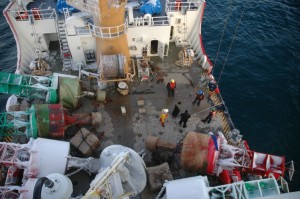
The buoys become covered in ice, but the deck underneath does not. The deck has heating cables underneath (approximately 35,000 feet of cable). This enables the ship to operate safely no matter how bad the winter conditions are. The ship is also fitted with a 30 ton capacity crane that is used for the recovering of buoys.
The vessel also is fitted to provide the essential service of environmental response. The ship contains a Vessel of Opportunity Skimming System (VOSS). This system skims oil off the surface of the water in the case of an oil spill. The cutter has the capability to use 2 inflatable barges holding up to 28000 gallons of water each (7). The USCGC Mackinaw WLBB-30 is an essential ship in the Great Lakes region that conducts multiple invaluable services to the shipping and recreational community. It’s building and commissioning was a monumental achievement for the Coast Guard and continues to prove its worth in the Great Lakes. The Mackinaw also is involved with law enforcement in the Great Lakes and search and rescue.
USCGC Mackinaw ’s Importance to U.S. Military
WLBB-30’s predecessor, WAGB-83, was not able to travel out of the Great Lakes region. It is believed by many people that this is because the ship was too wide to travel through the channels and locks to get out into the Atlantic Ocean. The real reason that the WAGB 83 could not travel to the ocean is because it contained raw water cooling piping (1). These pipes will erode in salt water and the ship could be dead in the water were it to be exposed to salt water for an extended period of time. The new Mackinaw uses different cooling piping that can withstand use in salt water opening up the possibilities for the ship were it needed outside the Great Lakes. There are two very important icebreaking operations in the Great Lakes region that WLBB-30 is involved in. The first operation is called Operation Taconite. Operation Taconite is the largest domestic icebreaking operation in the U.S. Shipping offers the only effective means of transporting vast amount of iron ore to steel mills in Lake Michigan and Lake Erie. The iron ore is used to make steel that is used by the U.S. military in the production of military technology. The Mackinaw is utilized to ensure the successful transport of this precious cargo in the harsh winters of the Great Lakes (4). The second operation is known as Operation Coal Shovel. Operation Coal Shovel is domestic icebreaking in the southern part of Lake Huron, Lake St. Clair, and the St. Clair and Detroit river systems. The Mackinaw serves Operation Coal Shovel by preventing ice jams in vital economic waterways. This helps make a continuous flow of maritime commerce in the Great Lakes region which can be vital for the U.S. military (3).
After the decommissioning of the first Mackinaw , it became vital to the military and economy of the United States to provide icebreaking in the Great Lakes region. The old Mackinaw was outdated and not applicable to the modern services that were needed in the Great Lakes. The United States Coast Guard then started the building of a new titan of icebreaking in the Great Lakes. The new ship had to be built to serve multiple functions other than ice breaking including aids to navigation, law enforcement, search and rescue, and environmental response. The new ship named the USCGC Mackinaw (WLBB-30) utilized new technology to become a unique ice breaker whose functions and operation are not matched by any previous ship in the fleet. The ship has continued to keep the extremely important flow of materials and commerce open in the Great Lakes. It has become vitally important to our military in order to keep materials that are needed for the construction of military goods. The Mackinaw (WLBB-30) is set in military history as one of the most innovative and vital resources in the Great Lakes region.
Primary Sources
- John Comar. Personal Interview. 19 November 2015.
- Clayton, Brian. “USCGC Mackinaw (WAGB 83) Final HAER.” Historic American Engineering Record (2005).
- “US and Canadian Coast Guard Commence Operation Coal Shovel.” U.S. Coast Guard Newsroom. 8 Jan. 2015.
- Operation Taconite Overview. United States Coast Guard, 2015.
Secondary Sources
- Stokes, Keith. “United States Coast Guard Cutter Mackinaw = WLBB 30.”Mighty Mac. 2006.
- Planisek, Sandra L. Icebreaker Mackinaw: WAGB 83, 1944-2006. Mackinaw City, Mich.: Great Lakes Lighthouse Keepers Association, 2006.
- ” USCGC Mackinaw (WLBB 30).” United States Coast Guard. U.S. Department of Homeland Security, 2015.
- “Fornes, Mike, and James E. Muschell. USCGC Mackinaw, WAGB 83: An Illustrated History of a Great Lakes Queen. Cheboygan, Mich.: Cheboygan Tribune Print., 2005. Print.
For Further Reading
- Fornes, Mike. USCGC Mackinaw (WLBB-30). Arcadia Publishing, 2015.

